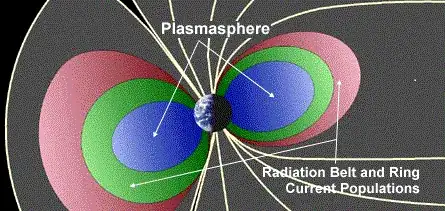The Voyager 1 probe was sent out in 1977 to go where no man made object has gone before, after more than 35 years it’s still going strong. It’s now 124 AU away from Earth and many are wondering when it’s going to leave our heliossphere and set off into unknown interstellar space. The readings from the probe have been more or less as expected until a dramatic change appeared. In August 2012. Voyager 1 entered a strange region where the solar wind came to a complete stop while the amount of cosmic rays set new records:

As Voyager 1 entered the new region, it seems like the region boundary where fluctuating back and forth. The magnetic field also strengthened as Voyager 1 entered the region, but the magnetic field did not change direction and that is the reason why the Voyager team has concluded that Voyager 1 is still in our heliossphere.
Voyager 1 is now in this new unknown region within our heliossphere and we don’t know what this region is. Here is a suggestion; the new region is a solar radiation belt.
Most scientists currently believe that the Sun has no radiation belts because the magnetic field, which turns every 11 years, is not stable enough to sustain a solar radiation belt. But recent observations from Earths outer radiation belts show that the belts can be drained and refilled with particles within weeks, so it may be time to take a second look at the possible existence of stellar radiation belts.
But why is the possible solar radiation belt so far from the Sun? Earths outer solar radiation belt is compressed by the solar wind, so a solar radiation belt may experience an opposite effect and get blown far away from the Sun, the unknown interstellar wind could on the other side push it against the sun.
The readings we got when Voyager 1 entered the new region may be explained by Voyager 1 leaving the high density solar plasmasphere and entering the low density energetic solar outer radiation belt.

-The observed disappearance of the solar wind could be Voyager 1 leaving the solar plasmasphere. Earths plasmasphere is filled with an outflow of ions from the ionosphere from low and mid-latitudes, which could be similar to the solar wind filling the solar plasmasphere. What happens to the solar wind ions on the threshold to this new region seems to be unclear, are they slowing down and piling up, or are they accelerated out of there?
-The observed sharp increase in cosmic rays could be energetic ions and electrons in the solar radiation belt itself. Ions with low cosmic ray velocity have recently been found in Earths radiation belts. We know that Jupiter has much stronger and more energetic radiation belts, so size amplify radiation belts and create cosmic ray velocity particles. We could then expect cosmic ray velocities to be normal in solar radiation belts which are located in a huge magnetic heliossphere. This also gives possible solutions to other cosmic ray problems, like why cosmic rays are decreasing during solar maximum, why cosmic rays can come in showers and temporary vary in particle type. It could also explain why we have found unstable isotopes in cosmic rays which cannot survive the long journey from the stars. Collisions with interstellar medium causing spallation are a proposed explanation of the unstable isotopes and the observed anti-matter, but collisions by the radiation belt with the solar wind will also give spallation and isotopes and anti-matter.
We currently don’t know what creates cosmic rays, supernovas is one proposal, but there is not enough supernovas in the universe to count for all the cosmic rays, so an additional source is needed. Cosmic rays from the radiation belts of stars could be such a source. If we have a solar outer radiation belt which is a Cosmic Ray source, CR-particles could also gyrate along solar magnetic field flux lines and bombard the Sun, with a much higher CR intensity than Earth experience in its magnetic field shielded quiet zone.
-Voyager 1 observed an increase in the magnetic field as it entered the new region. Earths outer radiation belt is also the home of Earths ring current which induces a magnetic field. So the solar radiation belt itself could harbor a solar ring current which induces a magnetic field which can explain the observed increase in the magnetic field:

-The observed fluctuations of the region boundary could be caused by irregular solar wind causing expansion and compression of the solar radiation belt, similar to how solar wind causes Earths radiation belt to fluctuate. The fluctuations could also be caused by variations in the solar magnetic field as the Sun spins.
-The number of cosmic rays hitting Earth is inverse proportional to the number of sunspots. An explanation to this could be that a varying solar magnetic field during solar maximum cannot sustain or confine a big stable outer radiation belt which may produce cosmic rays that hit Earth. It’s also possible that solar storms deplete the solar radiation belt of particles like solar storms deplete Earth’s outer radiation belts of particles.

The Voyager team states that Voyager 1 has not left the heliossphere, the observed region then have another explanation. A solar radiation belt may be a solution, and may also explain how the majority of cosmic rays may be created in stellar radiation belts. It’s a proposal which so far seems to fit well with the observations and it could give us some great answers. Any help in the evaluation process or comment is most appreciated. If the Sun and Earth have more in common than we think, this realization may lead us to further insights in how these great machinery's works.